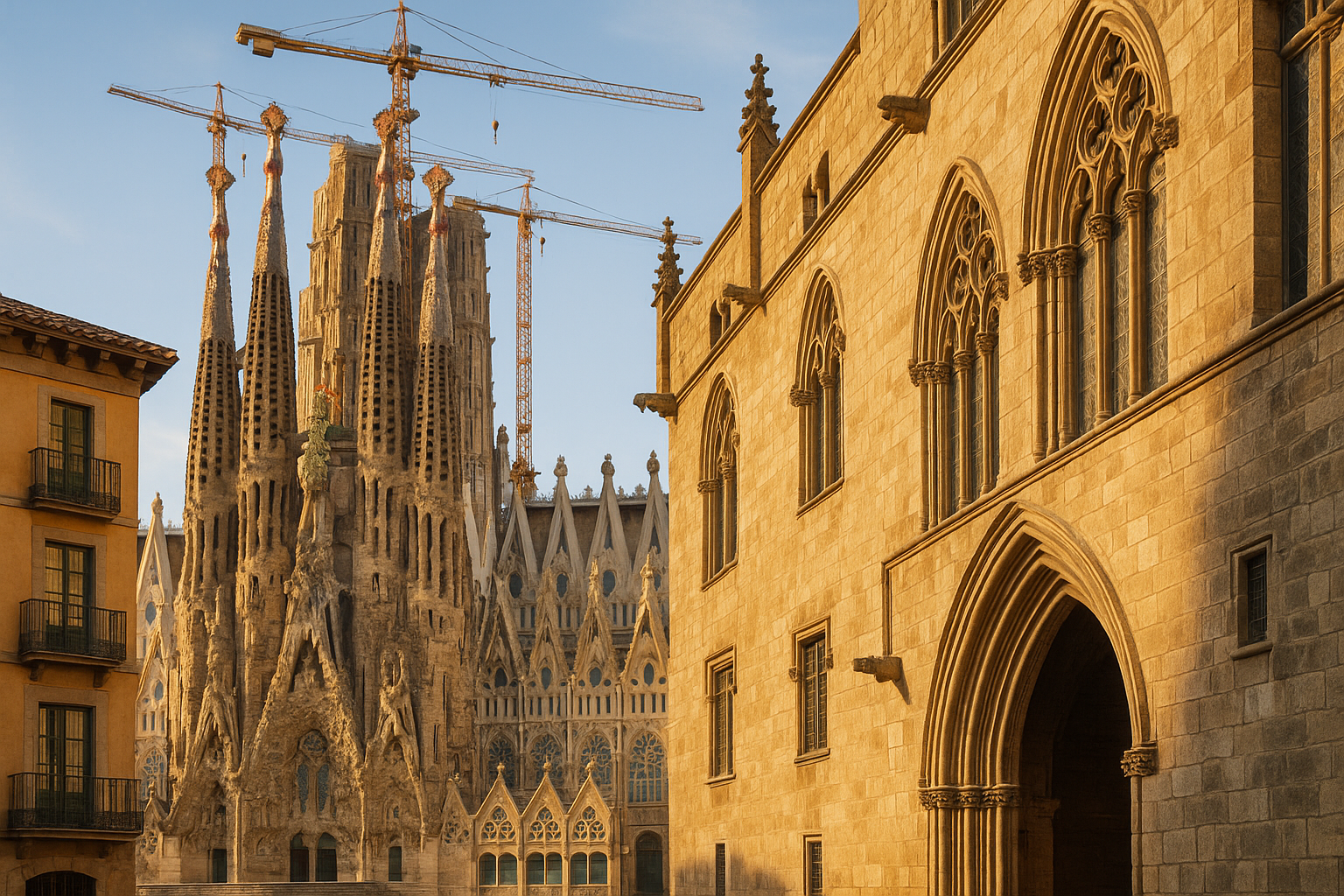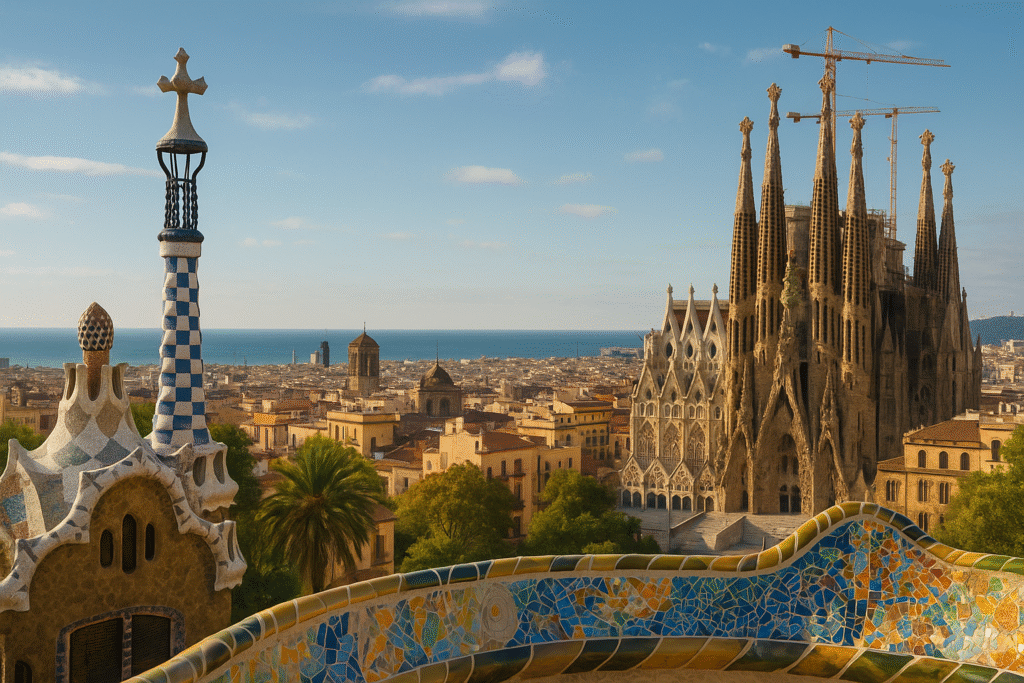Nestled between the azure Mediterranean and the rolling hills of Catalonia lies a city where architecture breathes life into every street corner, where the past converses with the present in an ongoing dialogue of stone and steel. Welcome to Barcelona, a city renowned not just for its vibrant culture and sun-kissed beaches, but for its unparalleled architectural tapestry. From the whimsical creations of Antoni Gaudí that defy gravity and imagination alike, to the solemn shadows cast by the spires of the Gothic Quarter, Barcelona architecture is an eloquent narrator of history, innovation, and artistry.
The Gaudí Legacy: Whimsy in Stone
Antoni Gaudí, whose name has become synonymous with Barcelona architecture, invites visitors into a world where imagination takes form in stone. His masterpiece, the Sagrada Família, stands as a testament to this architect’s visionary prowess, blending Gothic and Art Nouveau forms in a cathedral that remains under construction more than a century after it was begun. Each façade tells a different story, from the Nativity’s organic forms bursting with life and color to the Passion’s stark, angular intensity.
Park Güell, another of Gaudí’s creations, offers a playground of forms and colors that challenge conventional architectural norms. Originally conceived as a housing development, it now serves as a public park and a vivid example of Gaudí’s ability to harmonize architecture with nature. The playful mosaics and serpentine benches invite visitors to explore not just the park, but the very boundaries of architectural creativity.
The Modernista Movement: Beyond Gaudí
While Gaudí is often the face of Catalan Modernism, Barcelona architecture blossomed under the hands of many talented architects during the late 19th and early 20th centuries. Lluís Domènech i Montaner’s Palau de la Música Catalana is a riot of color and light, where stained glass and intricate mosaics create a vibrant atmosphere that complements the music within. This concert hall, a UNESCO World Heritage Site, exemplifies the Modernista ethos of integrating artistic disciplines into architectural design.
Another gem of the Modernista movement is the Hospital de Sant Pau, also designed by Domènech i Montaner. This architectural complex, with its gardens and pavilions, is not only a place of healing but also a celebration of beauty and function. The hospital’s intricate tile work and expansive courtyards illustrate how Barcelona architecture during this period was as much about creating spaces for community as it was about aesthetic expression.
The Gothic Quarter: Echoes of the Past
The Gothic Quarter, or Barri Gòtic, is a labyrinth of narrow alleys and hidden squares that transport visitors back to medieval Barcelona. Here, the city’s Roman origins meld seamlessly with its medieval past, creating a unique architectural dialogue. The Cathedral of Barcelona, with its soaring Gothic spires, anchors this historic district and stands as a monument to the city’s enduring spirit.
Wandering through the Gothic Quarter reveals a tapestry of history in stone. The Plaça del Rei, with its royal palace and ancient watchtower, speaks to Barcelona’s storied past. Nearby, the ancient Roman walls whisper tales of the city’s origins, while the Gothic arches of the Pont del Bisbe bridge capture the imagination with their mysterious allure, embodying the timeless charm of Barcelona architecture.
Beyond the Classics: Contemporary Barcelona
While the past is ever-present, contemporary Barcelona architecture boldly pushes the boundaries of design. The Torre Glòries, formerly known as Torre Agbar, is a modern icon of the city skyline. Designed by Jean Nouvel, this bullet-shaped skyscraper glows with an array of colors, reflecting the hues of the Mediterranean and the vibrancy of Barcelona itself.
Another contemporary marvel is the Barcelona Pavilion, originally designed by Mies van der Rohe for the 1929 International Exposition. Reconstructed in the 1980s, this minimalist masterpiece emphasizes open space and simplicity, offering a stark contrast to the ornate designs of the city’s historical structures. It stands as a reminder of Barcelona architecture’s commitment to innovation and adaptability.

The Influence of Nature in Design
Barcelona architecture is deeply influenced by its natural surroundings, a theme most vividly expressed in Gaudí’s works. However, this connection extends beyond Gaudí’s creations. The city’s urban planning reflects a balance between built environments and natural spaces. The Montjuïc hill, with its gardens and museums, offers panoramic views of the city and the sea, blending nature with culture.
The seafront, revitalized for the 1992 Olympics, is another example of this harmonious integration. The transformation of the Port Olímpic area showcases Barcelona’s ability to blend architectural development with environmental restoration, providing lush green spaces alongside sleek modern structures, thus enhancing the city’s unique coastal identity.
The Role of Light in Barcelona Architecture
Light plays a pivotal role in Barcelona architecture, from the stained glass of the Sagrada Família to the open courtyards of the Gothic Quarter. Architects have long harnessed the abundant Mediterranean sunlight to enhance their designs, creating dynamic spaces that shift and change with the movement of the sun.
The Palau Güell, one of Gaudí’s earlier works, exemplifies this with its innovative use of parabolic arches and light wells that illuminate the interior with natural light. This careful manipulation of light creates a sense of fluidity and movement, a hallmark of Barcelona architecture that continues to inspire architects today.
Preservation and Innovation: A Balancing Act
In a city where history is ever-present, the challenge lies in preserving the past while embracing the future. Barcelona architecture achieves this delicate balance through thoughtful urban planning and heritage conservation efforts. The city’s commitment to preserving its architectural heritage is evident in projects like the meticulous restoration of La Rambla, which maintains its historical charm while accommodating the needs of modern life.
At the same time, Barcelona fosters innovation through initiatives like the 22@ district, a hub for technology and design that transforms former industrial areas into vibrant neighborhoods. This convergence of preservation and innovation ensures that Barcelona remains a living, breathing city, where each brick tells a story of past, present, and future.
A City’s Architectural Dialogue
Barcelona is a city in constant conversation with itself, where each building is both a speaker and a listener in an ongoing architectural dialogue. As you wander its streets, you become part of this conversation, a participant in the dance of form and function, history and innovation. From Gaudí’s fantastical creations to the solemn grace of the Gothic Quarter, from the bold lines of contemporary skyscrapers to the carefully preserved relics of the past, Barcelona architecture is a symphony of styles and stories.
Conclusion
Barcelona’s architectural landscape is a testament to the city’s rich history and unyielding spirit of innovation. It is a place where every structure, from the ancient to the avant-garde, contributes to a narrative that is both deeply rooted in tradition and boldly forward-looking. As you explore this vibrant city, you will find that Barcelona architecture is not just a backdrop to its cultural life, but a central character in its story, inviting you to listen, learn, and be inspired.

Recent Posts
15 Floor Plan Graphic Styles That Will Elevate Your Presentation Game
The Role of Shadows in Architectural Storytelling
When Furniture Becomes Architecture: Blurring the Line